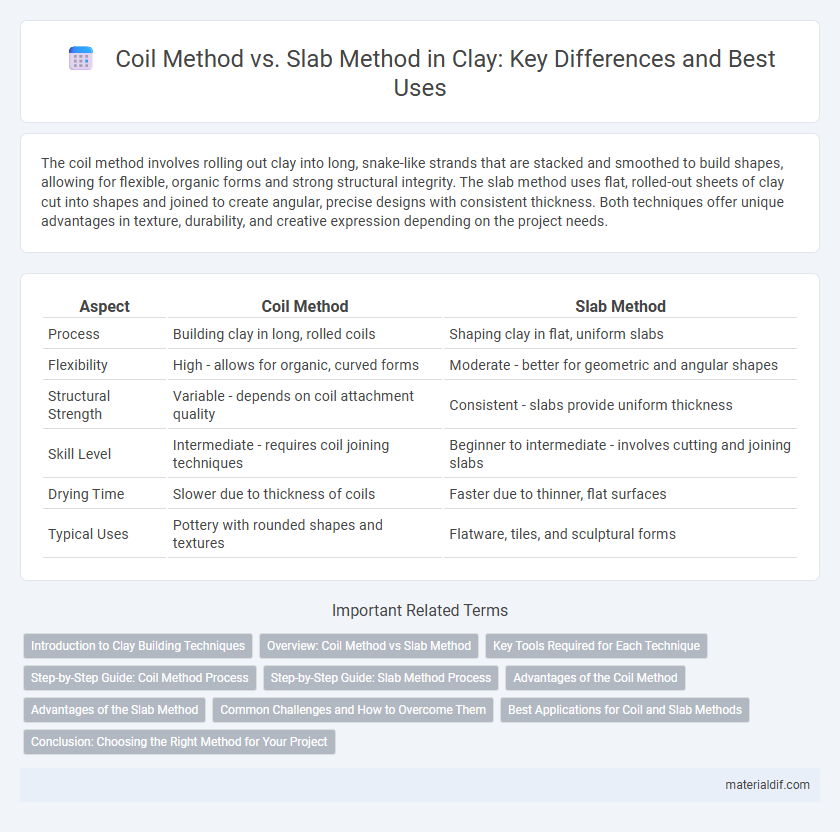The coil method involves rolling out clay into long, snake-like strands that are stacked and smoothed to build shapes, allowing for flexible, organic forms and strong structural integrity. The slab method uses flat, rolled-out sheets of clay cut into shapes and joined to create angular, precise designs with consistent thickness. Both techniques offer unique advantages in texture, durability, and creative expression depending on the project needs.
Table of Comparison
| Aspect | Coil Method | Slab Method |
|---|---|---|
| Process | Building clay in long, rolled coils | Shaping clay in flat, uniform slabs |
| Flexibility | High - allows for organic, curved forms | Moderate - better for geometric and angular shapes |
| Structural Strength | Variable - depends on coil attachment quality | Consistent - slabs provide uniform thickness |
| Skill Level | Intermediate - requires coil joining techniques | Beginner to intermediate - involves cutting and joining slabs |
| Drying Time | Slower due to thickness of coils | Faster due to thinner, flat surfaces |
| Typical Uses | Pottery with rounded shapes and textures | Flatware, tiles, and sculptural forms |
Introduction to Clay Building Techniques
The coil method involves stacking and joining long, rolled clay ropes to shape walls, offering greater flexibility for organic forms and detailed textures. The slab method uses flattened clay sheets that are cut and assembled, ideal for creating uniform, flat surfaces and angular shapes. Both techniques require proper scoring and slipping to ensure strong bonds between clay sections during construction.
Overview: Coil Method vs Slab Method
The coil method in clay involves rolling out long, snake-like rolls of clay stacked and smoothed to form walls, allowing for organic shapes and detailed textures. The slab method uses flat, evenly rolled sheets of clay cut and joined for a more uniform, structured construction suitable for geometric forms. Both techniques require precise scoring and slipping to ensure strong bonds between clay pieces, affecting the durability and finish of the final ceramic product.
Key Tools Required for Each Technique
The coil method requires essential tools such as a wire cutter, a rib for smoothing, and a needle tool for scoring and joining coils tightly. In contrast, the slab method depends on tools like a rolling pin or slab roller to create even slabs, a fettling knife for shaping edges, and a rib or sponge to smooth surfaces. Both techniques emphasize the importance of scoring and slipping tools to ensure proper adhesion between clay pieces.
Step-by-Step Guide: Coil Method Process
The coil method involves rolling long, snake-like coils of clay and stacking them to build up walls, creating sturdy and thick structures. Each coil is carefully blended and smoothed together to ensure uniformity and prevent cracks during drying and firing. This process allows for greater control in shaping and is ideal for creating rounded or organic forms with enhanced structural integrity.
Step-by-Step Guide: Slab Method Process
The slab method process begins with preparing a flat, stable base by compacting and leveling the soil, ensuring an even foundation for the clay slab. Next, a formwork is constructed to shape the slab dimensions, followed by mixing and pouring the clay material evenly into the formwork. Finally, the clay slab is leveled, smoothed, and left to cure properly, resulting in a solid and durable foundation for construction projects.
Advantages of the Coil Method
The Coil Method offers superior flexibility in shaping clay, enabling artists to create intricate and organic forms with ease. It allows for better control over wall thickness and structural stability, reducing the risk of cracking during drying and firing. This technique also promotes excellent moisture retention, minimizing warping and enhancing the overall durability of the finished pottery.
Advantages of the Slab Method
The slab method in clay construction provides superior structural stability and uniform load distribution compared to the coil method. It allows for a smoother surface finish, which reduces the need for excessive finishing work and enhances aesthetic appeal. This method also shortens drying time and decreases the risk of cracks due to its consistent thickness and controlled drying environment.
Common Challenges and How to Overcome Them
The Coil Method in clay sculpting often faces challenges such as uneven drying, warping, and cracking due to inconsistent coil thickness and moisture content. In contrast, the Slab Method can struggle with achieving uniform thickness and preventing air bubbles, which cause structural weaknesses during firing. Overcoming these issues requires precise control of clay moisture, consistent thickness measurement tools, and thorough joining techniques, such as scoring and slip application, to ensure stability and durability in both methods.
Best Applications for Coil and Slab Methods
The coil method is best suited for creating large, organic shapes and vessels with uneven surfaces, offering flexibility and speed in hand-building pottery. The slab method excels in producing geometric forms, flat surfaces, and structural pieces like boxes or tiles, providing precision and uniform thickness. Both techniques are essential for different artistic expressions and functional ceramics, with coil favored for rounded, bulky designs and slab ideal for angular, architectural elements.
Conclusion: Choosing the Right Method for Your Project
The coil method offers superior flexibility and allows for organic shapes, making it ideal for sculptures or intricate designs, while the slab method provides uniform thickness and structural stability, perfect for functional pottery and architectural elements. Project requirements such as desired texture, durability, and design complexity should guide the choice between these techniques. Selecting the appropriate clay forming method enhances the final product's quality and suitability for specific artistic or utilitarian goals.
Coil Method vs Slab Method Infographic

 materialdif.com
materialdif.com